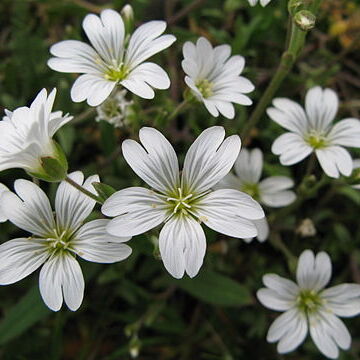Annual or perennial, usually pubescent, erect or decumbent herbs. Leaves opposite, usually sessile or subsessile, exstipulate, often viscid. Flowers few in dichasial cymes, white. Sepals 5, rarely 4, not connate. Petals as many as the sepals, rarely absent, emarginate or 2-cleft, white. Stamens 10, occasionally less; anthers versatile, 2-celled, longitudinally dehiscent; filaments flattened, scarcely if at all connate to form an obscurely glandular annulus. Ovary superior; carpels 5, rarely fewer, with as many distinct styles, the many campylotropous ovules arising from basal or central placentae. Capsule often arcuate (hence the generic name), dehiscing longitudinally into as many deeply emarginate valves as there are styles; seeds numerous, cochleate, usually tuberculate, estrophiolate, the embryo coiled about the perisperm.
Herbs annual or perennial, pubescent and/or glandular pubescent, rarely glabrous. Stems usually caespitose, sometimes slightly woody at base. Leaves ovate, elliptic, or lanceolate. Inflorescence terminal, a dichasial cyme, dense or lax, sometimes flowers solitary. Sepals (4 or)5, free. Petals (4 or)5, sometimes absent, white, apex usually 2-lobed or retuse, rarely entire. Stamens (3 or 5 or)10; nectaries present. Ovary 1-loculed; ovules numerous. Styles 3--5, inserted opposite sepals. Capsule golden yellowish, cylindric, sometimes subequaling but usually exceeding calyx, hard, thin, brittle, dehiscing by 2 × as many teeth as styles; teeth slightly curved, sometimes straight or revolute. Seeds numerous, globose or reniform, compressed, usually tuberculate; embryo annular.
Annual or perennial herbs, often glandular hairy, rather small, often caespitose, erect, procumbent or prostrate. Stems terete or slightly quadrangular. Leaves exstipulate, sessile or shortly petiolate. Flowers solitary or in few-to many-flowered dichasia, axillary or terminal. Sepals 5 (or 4), free, often with scarious margin. Petals 5 (or 4), white, eMarginate to bifid up to nearly half their length, rarely absent. Stamens 5 or most often 10 (or 8) inserted on a disc. Ovary (3-)5-carpellate, with numerous ovules; styles (3-)5. Capsule with twice as many teeth as there are styles, often curved and exserted from the calyx; opening by (6-)10 teeth, not more than 1/3 of the capsule length. Seeds reniform, spherical to broadly ovoid or compressed, verrucose.
Herbs, annual or perennial, rarely undershrubs (not in Australia), usually hairy. Stems decumbent to erect. Leaves opposite, petiolate or sessile, linear to broadly ovate; stipules absent; bracts herbaceous to subscarious. Flowers usually in cymes, rarely solitary, usually 5-merous, bisexual. Sepals 4 or 5, free. Petals white, emarginate to bifid, sometimes absent. Stamens 4, 5 or (8–) 10. Ovary 1-celled; styles usually (4) 5 (rarely 3 or 6 outside Australia). Capsule oblong, usually ± curved, opening by twice as many teeth as styles. Seeds numerous (c. 50–150), discoid or subnautiloid, tuberculate.
Annual or perennial herbs, sometimes subshrubs. Hairs usually dense, glandular and/or eglandular, rarely 0. Lvs opposite, exstipulate. Infl. cymose, sometimes reduced to solitary fl.; bracts and sepals herbaceous or with narrow to wide scarious margins; epicalyx 0. Sepals 5, free. Petals 5, white, emarginate or 2-fid up to ⅓ way, rarely 0; coronal scales 0. Stamens usually 10, sometimes 8, 5 or fewer. Styles (3)-5-(6). Fr. a cylindric capsule, often curved, dehiscing by twice as many short apical teeth as the styles, sessile. Seeds many, obovoid, spherical or reniform, tuberculate, not winged.
As in terminal cymes, or sometimes solitary; sep (4)5; pet (4)5, retuse to bifid or seldom entire, or occasionally wanting; stamens (4–)10; styles (3–)5; capsule usually surpassing the sep, cylindric, membranous, often curved, dehiscent by (6–)10 short apical teeth; seeds numerous, obovate-reniform, dorsally grooved, papillate-tuberculate; low annual or perennial herbs with rather small, opposite, exstipulate lvs. 100, widespread.
Capsule ellipsoid to cylindric, often somewhat curved, longer than the persistent sepals, or rarely as long as the sepals, opening by 6–10 apical, equal, short, erect or revolute teeth.
Inflorescences terminal, dichotomous, often umbelliform, occasionally with solitary flowers; bracts herbaceous or with membranous margins.
Seeds ± numerous, laterally somewhat flattened, discoid or reniform, granular or verrucose.
Leaves opposite, sessile or subsessile, flat or rarely subulate, entire, exstipulate.
Petals white, emarginate or bifid, sometimes absent.
Annual or perennial herbs, rarely small shrubs.
Ovary multiovulate; styles (3) 4–5, free.
Flowers bisexual, 4-merous or 5-merous.
Stems simple or dichotomously branched.
Sepals free with membranous margins.
Stamens 5 + 5 or fewer by reduction.

